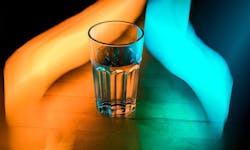Zero Waste: A Look at the Future of Reverse Osmosis
Most reverse osmosis systems waste as much as 20 gallons just to produce 1 gallon of product water. The new technology called "ZeroWaste" eliminates this problem by returning the concentrate water from the reverse osmosis system back to the home's plumbing, resulting in 100% efficiency.
With millions of gallons of water wasted daily by reverse osmosis systems in the United States alone, it is no surprise that ZeroWaste technology is coming to the forefront of the point-of-use (POU) industry. Watts Industries of North Andover, Massachusetts, is offering its ZRO-4 under counter system intended to target the independent water dealer market.
Even the best home reverse osmosis systems use 4 gallons of water for every 1 gallon produced. This typically is obtainable only if an Aqua-Tech permeate pump is used. Most systems waste as much as 20 gallons just to produce 1 gallon of product water.
The new technology called "ZeroWaste" eliminates this problem by returning the concentrate water from the reverse osmosis system back to the home's plumbing, resulting in 100% efficiency. There are several versions of zero waste available through various vendors but when shopping around, keep in mind that many of these systems will not meet plumbing codes. (The only known code-compliant process is the Watts Industries patented technology.) The system allows for a "legal" cross connection between the hot and cold water supplies, subsequently reintroducing the concentrate into the hot water side.
RELATED: What is Reverse Osmosis (RO)?
Here is How ZeroWaste Reverse Osmosis Works
The typical POU system is a five-stage unit utilizing three stages of pretreatment (one sediment and two carbon filtration) then a TFC membrane and subsequent permeate and concentrate waters being routed to both the tank and traditional drain connections.
The ZeroWaste system takes the water outlet of the sediment and carbon filters and routes it through a solenoid valve and pump before going to the membrane inlet. This provides filtered water to the solenoid and pump, which will keep foreign material from damaging them. Carbon block filters are preferred because they release fewer carbon fines, but GAC filters can be used if flushed with water prior to connecting them to the pump. (Carbon fines will damage the pump and solenoid.) In some systems the filter configuration allows for water to be routed through the solenoid valve and pumped from the water outlet of the sediment filter and then to the water inlet of the carbon filter(s).
A pressure switch will be used to stop the system by opening the circuit to the solenoid valve and pump. When the pressure in the reverse osmosis storage tank reaches a predetermined pressure indicating the tank is full, the pressure switch will open, stopping the system from producing more reverse osmosis water.
The concentrate water is routed through a flow restrictor as before, except the flow restrictor size is larger to allow for the back pressure of the hot water line. The flow restrictor rated size is from 500ml/m to 600ml/m. The larger flow restrictor will allow the pump to circulate water at approximately a 4 to 1 ratio of concentrate to permeate.
The actual flow ratio is the same as a standard reverse osmosis system with no back pressure from the tank.
International Association of Plumbing and Mechanical Officials (IAPMO) requires the water from the outlet of the flow restrictor be routed through two check valves before flowing to the hot water supply line. These check valves ensure the hot water will never reach the membrane on the reverse osmosis system due to a surge or back pressure in the hot water system.
All of the concentrate water from the reverse osmosis system will be routed to the hot water supply via a fitting on the angle stop valve under the sink. This valve is similar to the one on the cold water angle stop used to provide water to the system. The difference now is the concentrate water will be flowing into the house water system at the hot water angle stop valve and out of the water system at the cold water angle stop valve. This patented process allows for the traditional wash or concentrate water to be reused in the hot water side of the home.
None of the water is wasted to the drain by the reverse osmosis system. Instead it is filtered and then diluted in the hot water system of the house for other uses such as dishwashers, showers, hand washing, etc. Keep in mind that this concentrate has been filtered by sediment and carbon filtration and the only reintroduction is in the form of dissolved solids primarily consisting of calcium carbonates and sodium.
With the long and many times short-term outlook on water supplies appearing bleak, it is no surprise that zero waste reverse osmosis systems are here to stay. The efficiency of traditional reverse osmosis systems rated in the 10 percent to 20 percent range. With the new technology, the rating is 100 percent. As consumers become more aware of water costs and shortages zero waste technology will become a standard configuration.
Download: Here
